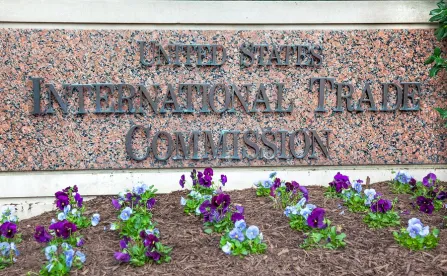On Tuesday, May 8, 2018, the International Trade Commission (“ITC” or the “Commission”) published the final changes to its rules of practice and procedure. The Commission stated that the changes are intended to both modernize and simplify Commission practice as well as to increase the speed and efficiency of investigations. In total, the Commission provided eleven amendments/additions to its current rules of practice and procedure, which take effect beginning on June 7, 2018. Going forward, the new rules will apply only to those Section 337 investigations instituted after that date; any investigations currently pending or filed before June 7 will proceed under the current rules. Of these changes, several may have a lasting impact on practice in Section 337 investigations, while other changes are minor but still require practitioners to take note.
Perhaps the most significant rule change is to rule 210.10(a)(6). Under this new rule the Commission will have the flexibility to institute multiple investigations from a single complaint, rather than instituting a single investigation that is too large for the Commission or an Administrative Law Judge (“ALJ”) to manage effectively. In addition to the Commission’s new ability to institute multiple investigations, new rule 210.14(h) allows Administrative Law Judges (“ALJs”) to sever an investigation into two or more investigations within 30 days of institution, though in cases where the ALJ splits a case, both of the resulting cases will stay with the same ALJ. The only criteria the rules list for the Commission and ALJs to consider when dividing cases is the consideration of efficient adjudication, though the Commission did not provide any concrete guidance regarding how this criteria will be applied, or which situations are most likely to be severed. However, the Commission did note that it expects that the Office of Unfair Import Investigations (“OUII”) will raise the issue with those submitting draft complaints for review, and may at times suggest modifications of draft complaints to avoid splitting.
The new rules regarding multiple investigations were apparently propounded in response to large complaints which in recent years have been difficult for the Commission to manage, particularly where many unrelated technologies, diverse products, large numbers of Respondents, or unrelated asserted patents are at issue. Section 337 practitioners can expect the Commission and ALJs to divide up Section 337 complaints into multiple investigations in the future, particularly where many unrelated technologies, diverse products, or unrelated asserted patents are at issue into separate investigations for more efficient adjudication. Practitioners should also expect that complaints including large numbers of patents, Respondents, or a wide breadth of accused products may be severed.
Another rule change effects preinstitution motion practice. Rule 210.15 has been amended to clarify that filing motions before the Commission during preinstitution proceedings is prohibited, except for motions for temporary relief pursuant to Rule 210.53. This change is likely to reduce the number of requests for the 100-Day Pilot Program and head off motions to sever or split a complaint into multiple investigations prior to institution.
The rule changes also formalize the 100-Day Pilot Program, which allows the Commission to issue an initial determination on potentially dispositive issues within 100 days of institution. In the past, the Commission has most often invoked the Pilot Program to resolve issues of standing and domestic industry, though there was not a formal limitation of the program to these topics. These changes provide authorization allowing the Commission to direct, in the notice of investigation, an ALJ to issue an initial determination on potentially dispositive issues within 100 days of institution. Rule 210.10(b)(3); 210.41(a)(3). But the ALJ can extend the 100-day period on a showing of good cause. Though the Commission does not explicitly limit or enumerate the issues which can be adjudicated in a 100-day proceeding, they do state that the issues that are appropriate for the proceedings are limited, and must entirely dispose of a case. The rules also provide for shortened timelines for parties to petition for Commission review of 100-day initial determinations, and also provide that if after 30 days the Commission has not decided to review the initial determination, that determination becomes final. Rule 210.43(a)(1), (a)(3).
As another departure from past practice, the Commission adopted a new requirement in rule 210.10(b)(1) that a notice of institution of an investigation state in plain language the accused products within the scope of the notice so to “make explicit what accused products or category of products” are the subject of the investigation. Prior to this change, the scope of the investigation has been as board as any products fairly categorized under the title of the investigation. This change will likely narrow Section 337 discovery, and should force Section 337 practitioners to be careful when drafting complaints to ensure the spectrum of accused products are adequately identified. The Commission has explicitly linked Rule 210.10(b)(1) with existing Rule 210.12(a)(12) requiring a complaint to contain a clear statement in plain English of the category of products accused, and practitioners should expect the notice of investigation to borrow from that statement.
The new rules also incorporate a number of interesting discovery changes which should make certain aspects of Section 337 investigations more efficient. Perhaps the most significant is the amendment of Rule 210.28(h)(3)(vi) to allow, within the discretion of the presiding ALJ, the use of an agreed-upon designated deposition instead of live witness testimony. If utilized by ALJs, it is likely that these designations will substitute for live testimony from third parties in many, if not most, investigations, which should streamline administrative hearings and reduce burdens on third parties. Rule 210.27(e)(5) has also been amended to create a presumption of privilege for communications between a party’s attorney and an expert witness retained on behalf of that party, bringing Commission practice in line with the Federal Rules, thereby obviating the need for the parties to negotiate these terms in a discovery stipulation. Rules 210.25(a)(1) and (2) were also amended to clarify that sanctions for abuse of discovery under 210.27(g)(3) may be raised by motion by any party or sua sponte by the ALJ or Commission. The Commission has also amended Rule 210.32 to bring Commission subpoena practice closer to the Federal Rules of Civil Procedure.
A number of more minor, procedural rule changes were made, including updating 201.16(a)(1) and (4) to allow the Commission to effect service through electronic means and 201.16(f) to allow the ALJ to specify by order what means of electronic service are acceptable to ensure secure storage and transmission of documents containing confidential business information. Other minor updates and new requirements include amending 210.12(a)(9) to require complaints to include the expiration date of each asserted patent, and updating Rule 210.19 to clarify that motions to intervene may be filed only after institution of an investigation or related proceeding.
All Commission practitioners should familiarize themselves with the new rules to ensure they continue to comply with the Commission’s requirements, as well as to identify potential opportunities or case strategies created by the new and amended rules.






 />i
/>i

